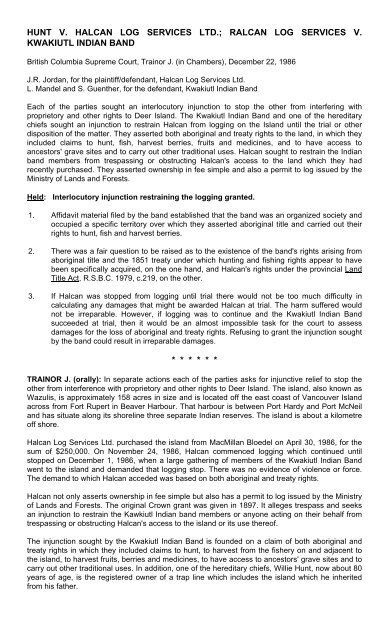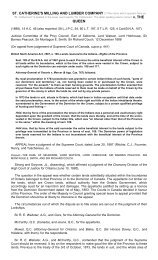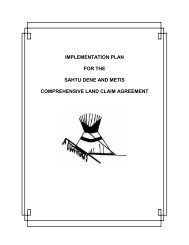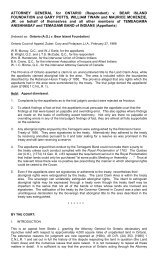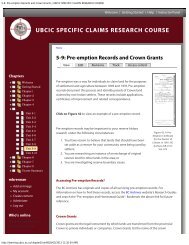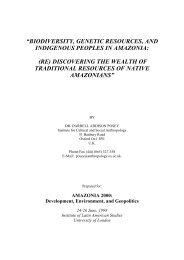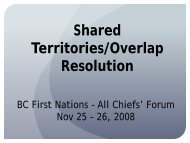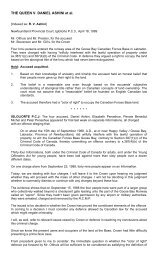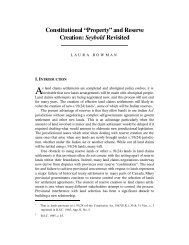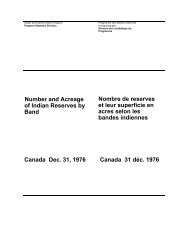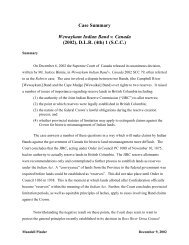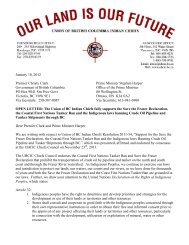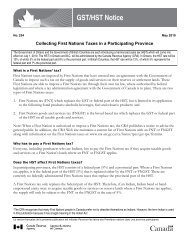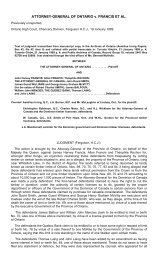HUNT V. HALCAN LOG SERVICES LTD.; RALCAN LOG SERVICES ...
HUNT V. HALCAN LOG SERVICES LTD.; RALCAN LOG SERVICES ...
HUNT V. HALCAN LOG SERVICES LTD.; RALCAN LOG SERVICES ...
Create successful ePaper yourself
Turn your PDF publications into a flip-book with our unique Google optimized e-Paper software.
<strong>HUNT</strong> V. <strong>HALCAN</strong> <strong>LOG</strong> <strong>SERVICES</strong> <strong>LTD</strong>.; <strong>RALCAN</strong> <strong>LOG</strong> <strong>SERVICES</strong> V.KWAKIUTL INDIAN BANDBritish Columbia Supreme Court, Trainor J. (in Chambers), December 22, 1986J.R. Jordan, for the plaintiff/defendant, Halcan Log Services Ltd.L. Mandel and S. Guenther, for the defendant, Kwakiutl Indian BandEach of the parties sought an interlocutory injunction to stop the other from interfering withproprietory and other rights to Deer Island. The Kwakiutl Indian Band and one of the hereditarychiefs sought an injunction to restrain Halcan from logging on the Island until the trial or otherdisposition of the matter. They asserted both aboriginal and treaty rights to the land, in which theyincluded claims to hunt, fish, harvest berries, fruits and medicines, and to have access toancestors' grave sites and to carry out other traditional uses. Halcan sought to restrain the Indianband members from trespassing or obstructing Halcan's access to the land which they hadrecently purchased. They asserted ownership in fee simple and also a permit to log issued by theMinistry of Lands and Forests.Held: Interlocutory injunction restraining the logging granted.1. Affidavit material filed by the band established that the band was an organized society andoccupied a specific territory over which they asserted aboriginal title and carried out theirrights to hunt, fish and harvest berries.2. There was a fair question to be raised as to the existence of the band's rights arising fromaboriginal title and the 1851 treaty under which hunting and fishing rights appear to havebeen specifically acquired, on the one hand, and Halcan's rights under the provincial LandTitle Act, R.S.B.C. 1979, c.219, on the other.3. If Halcan was stopped from logging until trial there would not be too much difficulty incalculating any damages that might be awarded Halcan at trial. The harm suffered wouldnot be irreparable. However, if logging was to continue and the Kwakiutl Indian Bandsucceeded at trial, then it would be an almost impossible task for the court to assessdamages for the loss of aboriginal and treaty rights. Refusing to grant the injunction soughtby the band could result in irreparable damages.* * * * * *TRAINOR J. (orally): In separate actions each of the parties asks for injunctive relief to stop theother from interference with proprietory and other rights to Deer Island. The island, also known asWazulis, is approximately 158 acres in size and is located off the east coast of Vancouver Islandacross from Fort Rupert in Beaver Harbour. That harbour is between Port Hardy and Port McNeiland has situate along its shoreline three separate Indian reserves. The island is about a kilometreoff shore.Halcan Log Services Ltd. purchased the island from MacMillan Bloedel on April 30, 1986, for thesum of $250,000. On November 24, 1986, Halcan commenced logging which continued untilstopped on December 1, 1986, when a large gathering of members of the Kwakiutl Indian Bandwent to the island and demanded that logging stop. There was no evidence of violence or force.The demand to which Halcan acceded was based on both aboriginal and treaty rights.Halcan not only asserts ownership in fee simple but also has a permit to log issued by the Ministryof Lands and Forests. The original Crown grant was given in 1897. It alleges trespass and seeksan injunction to restrain the Kawkiutl Indian band members or anyone acting on their behalf fromtrespassing or obstructing Halcan's access to the island or its use thereof.The injunction sought by the Kwakiutl Indian Band is founded on a claim of both aboriginal andtreaty rights in which they included claims to hunt, to harvest from the fishery on and adjacent tothe island, to harvest fruits, berries and medicines, to have access to ancestors' grave sites and tocarry out other traditional uses. In addition, one of the hereditary chiefs, Willie Hunt, now about 80years of age, is the registered owner of a trap line which includes the island which he inheritedfrom his father.
If logging was permitted to continue, it would be completed in about 30 days. The Kwakiutl IndianBand says its members would be harmed irreparably from the losses to them from that logging.Central to the rights of Halcan is the Land Title Act, R.S.B.C. 1979, c.219. Section 23(1)(a)provides:23.(1) Every certificate of indefeasible title, as long as it remains in force and uncancelled,shall be received in evidence in all courts without proof of the seal or signature, and shallbe conclusive evidence at law and in equity, as against the Crown and all other persons,that the person named in the certificate is indefeasibly entitled to an estate in fee simple inthe land described in the certificate, subject to(a) the subsisting conditions, provisos, restrictions, exceptions and reservations,including royalties, contained in the original grant or contained in any other grant ordisposition from the Crown;The treaty on which the band relies was signed at Fort Rupert on February 8, 1851, and therelevant part is:That the chiefs do consent to surrender entirely and for ever to James Douglas, the agent ofthe Hudson's Bay Company on Vancouver Island, that is to say, for the Governor, DeputyGovernor and Committee of the same the whole of the land situate and lying betweenMcNeil's Harbour and Hardy Bay inclusive of these ports and extending 2 miles into theinterior of the island.The condition of or understanding of the sale is this, that ourvillage sites and enclosedfields are to be kept for our own use, for the use of our children, and for those who mayfollow after us; and the land shall be properly surveyed hereafter. It is understood, however,that the land itself, with these small exceptions, becomes the entire property of the whitepeople for ever; it is also understood that we are at liberty to hunt over the unoccupiedlands, and to carry on our fisheries as formerly.The three reservations I mentioned on Beaver Harbour and near Fort Rupert are within thegeographical area surrendered by the treaty and likely would fit the description of village sites,aboriginal enclosed fields.The band says it exercised hunting rights on the island from time immemorial and that it was andremains "unoccupied" land. Halcan says that its occupation of the island commenced with thelogging on November 24, 1986. The band says that the recognition of the right in the treaty "tocarry on our fisheries as formerly" includes the shoreline of and the water surrounding the island.The claim is that a logging operation would so disrupt those areas that it would suffer significantand irreparable loss.The issues to be considered in the two actions and which are relevant to the interlocutoryinjunction applications before me include :(1) Whether the Kwakiutl Indian Band has aboriginal title and rights to Deer Island.(2) Whether the 1851 treaty created rights to hunt on Deer Island and to use the fisheries on andaround the island.(3) Were any of those rights existing when the Constitution Act, 1982 was passed?(4) What is the effect of the Crown grant on aboriginal or treaty rights?(5) What is the effect of s.23 of the Land Title Act?(6) If aboriginal or treaty rights can be extinguished, what steps, including, for example, notice arenecessary to accomplish this end?(7) Arising from those issues is there a fair question to raise as to the existence of the rightsalleged. To put it more succinctly, is there a serious question to be tried?(8) Would refusing to grant the injunction asked for result in irreparable damage or would anydamages ultimately awarded be an adequate remedy?
(9) What is the balance of convenience if there is doubt as to the adequacy of respective remediesin damages?It should be noted that neither the provincial or federal Crown are parties to these proceedings.The evidence on this hearing consisted of a number of affidavits sworn by band members, abiologist , an archaeologist, a fisheries officer and by Archie Haleta, a principal of Halcan. I gaveleave f o r the cross-examination of Mr. Haleta on his affidavits and heard that evidence. It was notuntil the last day of the hearing that counsel for Halcan produced an affidavit containing a newproposal for log removal apparently designed to reduce damage to foreshore and to kelp beds.It would not be correct to leave the impression that the island had never been used for purposesother than fishing and hunting over the years. I will review the uses made by the band but I want tomention the fact that a small kelp factory operated there for a short period, between 1912 and1914. Deer Island was used as the site of a full length motion picture entitled "Land of theHeadhunters" or "Land of the War Canoes". The movie made by Edward Curtis, known for hiswork on aboriginal Indian life in North America, is described as being "about the aboriginal life ofthe Kwakiutl, a spectacular maritime people of the Northwest Coast, vastly different from the tribesof the mountains and plains". The actors were band members who used authentic costumes andcanoes.I will review the evidence under the headings of the various issues I listed above. In doing so Ihave in mind the caution stated by Mr. Justice Seaton in MacMillan Bloedel Ltd. v. Mullin; Martin v.R. in right of B.C. (1985), 61 B.C.L.R. 145 at p. 151, [1985] 3 W.W.R. 577 [[1985] 2 C.N.L.R. 58 at65], the Meares Island case, where he said, in speaking of the claims of Indian title:The questions raised by the claim are not the type of questions that should be decided onan interlocutory application. A great amount of factual evidence will have to be heard andconsidered, opinion evidence of those knowledgeable in these matters will have to beassembled and related to the factual evidence, and there will have to be a meticulous studyof the law. That must take place at a trial; it cannot be done on an interlocutory application.All that we can decide here is whether the claim is one that ought to be tried. I have notrouble with that question.I do not intend to say more on this issue -the trial judge should not be fettered in hisconsideration by anything said here or anything said by the chambers judge.And, of course, I fall into that category of being the chambers judge on these applications.With respect to the first issue, which is whether the Kwakiutl Indian Band has aboriginal title andrights to Deer Island.On this subject, in Kruger and Manuel v. The Queen (1977), 75 D.L.R. (3d) 434 at p.437, 34C.C.C. (2d) 377, [1978] 1 S.C.R. 104 at pp.108-9, Mr. Justice Dickson, as he then was, said:Before considering the two other grounds of appeal, I should say that the importantconstitutional issue as to the nature of aboriginal title, if any, in respect of lands in BritishColumbia, the further question as to whether it had been extinguished, and the force of theRoyal Proclamation of 1763 -issues discussed in Calder et al. v. A.G. B.C. (1973), 34D.L.R. (3d) 145, [1973] S.C.R. 313, [1973] 4 W.W.R. 1 - will not be determined in thepresent appeal. They were not directly placed in issue by the appellants and a sound rule tofollow is that questions of title should only be decided when title is directly in issue.Interested parties should be afforded an opportunity to adduce evidence in detail bearingupon the resolution of the particular dispute. Claims to aboriginal title are woven withhistory, legend, politics and moral obligations. If the claim of any Band in respect of anyparticular land is to be decided as a justiciable issue and not a political issue, it should beso considered on the f acts pertinent to that Band and to that land, and not on any globalbasis.In Hamlet of Baker Lake v. Minister of Indian Affairs and Northern Development. (1979), 107D.L.R. ( 3d) 513 at p. 542, [1980] 1 F.C. 518, [1980] 5 W. W. R. 193 [[1979] 3 C.N.L.R. 17 at p.45], Mr. Justice Mahoney listed the elements which must be proven to establish an aboriginal titlecognizable at common law as follows:1. That they and their ancestors were members of an organized society.
2. That the organized society occupied the specific territory over which they assert the aboriginaltitle.3. That the occupation was to the exclusion of other organized societies.4. That the occupation was an established fact at the time sovereignty was asserted by England.Then at p.545 [p.48 C.N.L.R.] he cited Mr. Justice Baldwin in delivering the opinion of the court inMitchell v. United States (1835), 9 Peters 711 at p.746:Indian possession or occupation was considered with reference to their habits and modesof life; their hunting-grounds were as much in their actual possession as the cleared fieldsof the whites; and their rights to its exclusive enjoyment in their own way and for their ownpurposes were as much respected, until they abandoned them, made a cession to thegovernment, or an authorized sale to individuals ....The merits of this case do not make it necessary to inquire whether the Indians within theUnited States had any other rights of soil or jurisdiction; it is enough to consider it as asettled principle that their right of occupancy is considered as sacred as the fee-simple ofthe whites.The affidavit material is quite sufficient to satisfy me that the Kwakiutl Indian Band is an organizedsociety complete with a system for selection of leaders on whom responsibility rests f o r carryingon their traditions including the care and protection of traditional territories. There is evidence ofsome use of the island by people who are not members of the band, principally for camping andrecreation, but this sharing has been accepted and encouraged by the band without any lesseningof authority over the island.The occupation of the island by the Kwakiutl appears from its use in a number of ways. It is aburial place considered to be spiritual or sacred. It is a major source of food and used throughoutthe year for that purpose. I will refer to the affidavit of Chief Peter Knox in which he said:I have fished and gathered food in the Beaver Harbour and surrounding (Queen CharlotteSound) area for many years. Wazulis (Deer Island) remains the centre of fishing and foodgathering because of its location of convenience to the Fort Rupert area and because of themany kinds of sea foods and game living on and around the Island. All of the places that wegather food were Identified by our parents and their parents before them, and of all theareas in Beaver Harbour, Wazulis is the most used for food gathering and has the mostareas identified for that purpose. In the winter months, because of storms, it is dangerous togo beyond Beaver Harbour, and for this reason Wazulis becomes the prime winter foodgathering spot. It is the place in Beaver Harbour closest to Fort Rupert village.I fish and collect seafood in and close to Wazulis more than half of the days in every year,often with other members of the Band assisting me and doing food gathering for their ownfamilies.The biologist, whose affidavit was filed, is Pat Miller. She said in her affidavit, para.18:I was impressed by the diversity of marine species that I observed along the shores of DeerIsland. This diversity is due to the availability of a variety of different types of habitats,ranging from those which are typical of a sheltered environment, rich in depositions of sand,gravel and shells, and an exposed environment where the action of the surf promotes thegrowth of organisms which are characteristic of wave-exposed rocky shores.Again, in the affidavit of Chief Peter Knox, he attached as an exhibit a map of the island which hasaround its border numbers and he identified in his affidavit the various fish and other products ofthe sea which could be found in those areas. For example, going through his affidavit verygenerally, he talks of clams and their location and the quantities of clams which are removable forconsumption by families and for commercial purposes.Then he talks about the location of abalone, mussels, herring roe, salmon, cockles, barnacles, seaurchins, ground fish such as rock cod, ling cod and halibut, octopus, chitons, seals, mink, deer,ducks, sea otters, and then various kinds of berries that are found on the island.
Another use claimed is that the site with its trees acts as a wind-break for the settlements alongthe shoreline of the harbour. Evidently, 80-knot winds are not uncommon in the winter. It would notbe unreasonable to expect that protection of that kind would continue.I turn then to the second point which is the 1851 treaty under which hunting and fishing rights appearto have been specifically acquired.In R. v. White and Bob (1964) , 50 D.L.R. (2d) 613, 52 W.W.R. 193, the British Columbia Court ofAppeal considered a treaty with wording identical to the treaty before me. At p. 618 Mr. JusticeDavey said:Legislation that abrogates or abridges the hunting rights reserved to Indians under thetreaties and agreements by which they sold their ancient territories to the Crown and to theHudson's Bay Company for white settlement is, in my respectful opinion, legislation inrelation to Indians because it deals with rights peculiar to them. Lord Watson's judgment inSt. Catherine's Milling & Lumber Co. v. The Queen (1888), 58 L.J.P.C. 54, if any authority isneeded, makes that clear. At p.60 he observed that the plain policy of the B.N.A. Act is tovest legislative control over Indian affairs generally in one central authority. On the samepage he spoke of Parliament's exclusive power to regulate the Indians' privilege of huntingand fishing. In my opinion, their peculiar rights of hunting and fishing over their ancienthunting grounds arising under agreements by which they collectively sold their ancientlands are Indian affairs over which Parliament has exclusive legislative authority, and onlyParliament can derogate from those rights.A similar treaty was considered by the British Columbia Court of Appeal in R. v. Bartleman (1984),12 D.L.R. (4th) 73, 13 C.C.C. (3d) 488, 55 B.C.L.R. 78, [1984] 3 C.N.L.R. 114. The question waswhether the privately owned land on which an Indian was hunting was unoccupied. It was found soto be and an acquittal was entered.At p.85 D.L.R., p.90 B.C.L.R. [p.125 C.N.L.R.], Mr. Justice Lambert said:The Crown also accepts that , at the time of the treaties, it was a concern of the Colonialgovernment not to disturb the Indian people in their traditional food-gathering activities. Itwas in the interests of the government of the Colony of the Vancouver Island, and of theIndians, that the Indians should be able to support themselves in their traditional ways.And at p.89 D.L.R., p.94 B.C.L.R. [p.129 C.N.L.R.], he said:In the present case, there are a number of possible interpretations of the agreement thatwas reached between the Hudson's Bay Company and the Saanich people ...He listed three interpretations, the third of which was this:3. That the rights of the Indians to hunt and fish were to be confirmed with respect to theland being ceded to the Hudson's Bay Company by the treaty, so long as it wasunoccupied, but also were to be confirmed generally with respect to all the land where theSaanich tribe had traditionally hunted and fished, so long as that land was unoccupied.I think the third interpretation is the correct interpretation.With respect to the issue of the extinguishment of aboriginal title, there is a paragraph in the caseof Hamlet of Baker Lake v. Minister of Indian Affairs, supra, at p.549 [p.52 C.N.L.R.] on whichcounsel for Halcan relies. Mr. Justice Mahoney said:The coexistence of an aboriginal title with the estate of the ordinary private land holder isreadily recognized as an absurdity. The communal right of aborigines to occupy it cannot bereconciled with the right of a private owner to peaceful enjoyment of his land. However, itscoexistence with the radical title of the Crown to land is characteristic of aboriginal title andthe company, in its ownership of Rupert's Land, aside from its trading posts, was very muchin the position of the Crown. Its occupation of the territory in issue was, at most, notional.And at p.551 [p.55 C.N.L.R.] he says:No Canadian legislation requiring that legislative extinguishment of aboriginal titles beeffected in a particular way, has been brought to my attention ....
I cannot accept the plaintiff's argument that the Parliament's intention to extinguish anaboriginal title must be set forth explicitly in the pertinent legislation. I do not agree that Mr.Justice Hall went that far. Once a statute has been validly enacted, it must be given effect. Ifits necessary effect is to abridge or entirely abrogate a common law right, then that is theeffect that the Courts must give it.And he quoted [at p.552 [p.56 C.N.L.R.]] from the judgment of Mr. Justice Judson in the Calder v.A.G.B.C. (1973), 34 D.L.R. (3d) 145 at p.167, [1973] S.C.R. 313, [1973] 4 W.W.R. 1, as follows:In my opinion, in the present case, the sovereign authority elected to exercise completedominion over the lands in question, adverse to any right of occupancy which the NishgaTribe might have had, when, by legislation, it opened up such lands for settlement, subjectto the reserves of land set aside for Indian occupation.Mahoney J. continued:To say that the necessary result of legislation is adverse to any right of aboriginaloccupancy is tantamount to saying that the legislator has expressed a clear and plainintention to extinguish that right of occupancy. Justices Hall and Judson were, I think inagreement on the law, if not its application in the particular circumstances.The question of extinguishment of the right is considered in extenso in A.G. Ont. v. Bear IslandFoundation; Potts v. A.G. Ont. (1984), 15 D.L.R. (4th) 321, 49 O.R. (2d) 353, [1985] 1 C.N.L.R. 1.Then, in Simon v. The Queen which, I believe, is still an unreported decision of the Supreme Courtof Canada, 1985 [now reported [1986] 1 C.N.L.R. 153, 24 D.L.R. (4th) 390, 23 C.C.C. (3d) 238,[1985] 2 S.C.R. 387, Chief Justice Dickson, in giving the judgment of the court, said at p.21[pp.169-70 C.N.L.R.]:The respondent submits that absolute title in the land covered by the treaty lies with theCrown and, therefore, the Crown has the right to extinguish any Indian rights in such lands.The respondent further submits, based on Isaac [R. v. Isaac (1975), 13 N.S.R. (2d) 460]that the Crown, through occupancy by the white man under Crown grant or lease, has, ineffect, extinguished native rights in Nova Scotia in territory situated outside of reserve lands....In my opinion it is not necessary to come to a final decision on the respondents argument.Given the serious and far-reaching consequences of a finding that a treaty has beenextinguished, it seems appropriate to demand strict proof of the fact of extinguishment ineach case where the issue arises. As Douglas J. said in United States v. Santa Fe PacificRy. Co., supra [314 U. S. 339], at p.354, "extinguishment cannot be lightly implied".And at p.23 [pp.170-71 C.N.L.R.]:The respondent tries to meet the apparent right of the appellant to transport a gun andammunition by asserting that the treaty hunting rights have been extinguished. In order tosucceed on this argument it is absolutely essential, it seems to me, that the respondent leadevidence as to where the appellant hunted or intended to hunt and what use has been andis currently made of these lands. It is impossible for this Court to consider the doctrine ofextinguishment "in the air" ; the respondent must anchor that argument in the bedrock ofspecific lands. ... I do not wish to be taken as expressing any view on whether, as a matterof law, treaty rights may be extinguished.I turn then to the next issue stated which relates to the Constitution Act, 1982. It provides bys.35(1):35.(1) The existing aboriginal and treaty rights of the aboriginal peoples of Canada arehereby recognized and affirmed.This raises the question for possible consideration by the trial judge, based on evidence, that it isnot something that ought to be considered on an interlocutory application of this kind. This wasreferred to in the judgment of Mr. Justice Steele in the Bear Island case, supra, at p.408 [p.81C.N.L.R.]. He said:
I disagree with the defendant's contention that the Constitution Act, 1982 protects theaboriginal and treaty rights of the aboriginal peoples of Canada as these rights existed in1763 .... It is only those rights that still survived at the time of proclamation of theConstitution Act, 1982 that are protected, and no others....Jurisdiction over Indians and lands reserved for Indians is vested in the federal Crown:Constitution Act, 1867, s.91(24). Section 109, which applies to British Columbia, provides that landin the province belongs to the provincial Crown, "subject to any Trusts existing in respect thereof,and to any Interest other than that of the province in the same".On that basis a question arises whether there was a surrender of Deer Island by the 1851 treatyand possible effects on the rights apparently reserved under s.109. The effect of such a surrenderis commented on by Chief Justice Dickson in Guerin v. The Queen (1984), 13 D.L.R. (4th) 321,[1984] 2 S.C.R. 335, [1984] 6 W.W.R. 481, [1985] 1 C.N.L.R. 120. He said at p.338 D.L.R., p.498W.W.R. [p.135 C.N.L.R.]:When the land in question in St. Catherine's Milling [supra] was subsequentlydisencumbered of the native title upon its surrender to the federal government by the Indianoccupants in 1873, the entire beneficial interest in the land was held to have passed,because of the personal and usufructuary nature of the Indians' right to the Province ofOntario under s.109 rather than to Canada. The same constitutional issue arose recently inthis court in Smith et al. v. The Queen (1983), 147 D.L.R. (3d) 237, [1983] 1 S.C.R. 554, 47N.R. 132 [[1983] 1 C.N.L.R. 161] sub nom. Government of Canada v. Smith in which thecourt held that the Indian right in a reserve, being personal, could not be transferred ....Upon surrender the right disappeared "in the process of release".In my opinion and based on my assessment of those issues, there is a fair question to raise as tothe existence of the rights arising from aboriginal title and the treaty on the one hand and theprovincial Land Title Act on the other.I turn to the question of damages which I posed as number 8, "Would refusing to grant theinjunction asked for result in irreparable damage or would any damages ultimately awarded be anadequate remedy?"Although Archie Haleta has been associated with the logging business for some time, his companyHalcan has only been in existence for approximately five years. He classified the Deer Islandproject as large in the scale of its operations. Prior to 1986 Halcan had no equipment and usedcontractors to get out timber it had purchased. In preparation for the logging of Deer Island Haletaclaimed to have purchased equipment having a value of approximately $300,000, which is aconsiderable outlay for a 30-day project. In addition, he claims to have expenses of the crew whichstarted to log the island in the amount of approximately $2,000 per day, although oncross-examination this expense appeared to be only a rough general estimate.Before selling the island to Halcan, MacMillan Bloedel estimated that there were approximately30,000 cubic meters of timber on it. At an average value of $42.50 per cubic meter the value of thetimber on the island is well in excess of one million dollars.If the result of these proceedings is to stop Halcan from logging until the trial , I would not thinkthere would be too much difficulty in calculating any damages which might be awarded Halcan attrial. I do not find in its claim any elements of logging is not stopped irreparable loss. If the as aresult of these proceedings and Halcan removes the timber and sells it has, then success at trialby the pursuant to the contract Kwakiutl Indian Band would put on this court the nearly impossibletask of assessing damages for the loss of the aboriginal and treaty rights I have described. In myview, refusing to grant the injunction could result in irreparable damages.In the Meares Island case, supra, Mr. Justice Seaton compared the respective positions of thoseparties on this question. And he said, at p-158 [pp.71-72 C.N.L.R.]:Meares Island is of importance to MacMillan Bloedel, but it cannot be said that denying orpostponing its right would cause irreparable harm. If an injunction prevents MacMillanBloedel from logging pending the trial and it is decided MacMillan Bloedel has the right tolog, the timber will still be there.
The position of the Indians is quite different. It appears that the area to be logged will bewholly logged .... The subject matter of the trial will have been destroyed before the rightsare decided.And at p.159 he said [pp.72-73 C.N.L.R.]:I have emphasized the material and symbolic importance of Meares Island to the Indians,but its cultural importance should not be disregarded.. . .A separate consideration that leads to the same conclusion is the need to preserveevidence. The Indians need time to carefully examine the area to be logged to see whetherthere is any evidence that ought to be recorded or preserved.Counsel for Halcan submits that to refuse to prohibit trespassers on the island would cast doubt ontitle under the Land Title Act. That may be , but it did not sway Mr. Justice Seaton in the MearesIsland case where he dealt with this question at p.160. He said [p.73 C.N.L.R.]:It has also been suggested that a decision favourable to the Indians would cast doubt onthe tenure that is the basis for the huge investment that has been and is being made. I amnot influenced by the argument.Nor was this submission a factor in the decision in the Bartleman case, supra, where the propertywas privately owned as here, and it was found not to have been occupied by the owner.Occupation surely must be a matter for the trial judge. If there is doubt on tenure, that should beremoved by full consideration in the trial process.Leave was granted to four intervenors to appear and be heard on these applications. They did sothrough one counsel but each filed an affidavit supporting the position taken by the Kwakiutl IndianBand. They do not make a claim for damages. One of the affidavits had annexed to it a furtherstatement in opposition to Halcan signed by approximately 140 people. Their evidence was thatlogging would bring immediate harm and loss in the loss of wind protection, aesthetic damage andruination of the public use of the island for recreation and as a fishery. Their submission is thatthere is an effect on the public use and benefit of natural resources and the detrimental effect ontheir land values.In accepting their evidence in these proceedings, I do so because it in large measure is relevant toissues raised by the Kwakiutl Indian Band. In doing so, however, I would not want to beunderstood as encouraging a participation of members of the general public to express their viewsin litigation designed to resolve the specific problems of the litigants. To do so would be to allow apolitical approach to the resolution of judicial questions.The Kwakiutl Indian Band is entitled to the order sought in its notice of motion, that is Halcan LogServices Limited and anyone acting under its instructions are enjoined from logging on DeerIsland until the trial or other disposition of this matter.The motion of Halcan to enjoin the Kwakiutl Indian Band, its members and anyone acting under itsinstruction from trespassing on Deer Island is dismissed. To grant the order sought would be toprohibit the Kwakiutl from having access to the island to visit burial grounds and carry outtraditional ceremonies. It would also stop them from exercising the rights they claim to hunt,harvest toots, berries and fish on and around the island. To permit a continuation of thoseactivities during the interim period until trial will cause no harm to Halcan.The other orders asked for relate to questions of force, threats, intimidation and conspiracy toinjure. There is no evidence of conduct on which such orders might be based. Those applicationsare dismissed.


